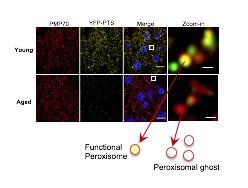
Credit: Hua Bai
AMES, Iowa – A new study that looks closely at the cardiac health of flies provides new evidence that liver dysfunction may lead to deterioration of the heart.
The research fills in gaps in how scientists understand the links between heart health and other tissues and could inform the development of new therapies in human medicine, said Hua Bai, an assistant professor of genetics, development and cell biology at Iowa State University. Bai’s lab has performed previous studies on how cardiac health in flies changes with age. The new study, published in the academic journal Nature Communications, also covers new ground in the function of a poorly understood organelle called the peroxisome, which may play a major role in how organisms age.
“We were thinking outside the heart for this paper,” Bai said. “We wanted to find out if other tissues affect cardiac function during aging. There is significant data suggesting that liver function actually is a risk factor for cardiac disease. A patient with a lot of liver dysfunction often develops cardiac disease. This is a concern because you may have two diseases that you have to deal with for these patients.”
But Bai said no direct link between liver and heart disease has emerged in experiments, leaving medical professionals unsure if the two factors share a causal relationship or if there’s simply a correlation. Bai’s lab attempted to fill that gap by studying the interaction between liver disease and the function of cardiac muscles in flies.
Protecting the liver maintains heart health
Previous studies from Bai’s lab showed that manipulating genes in the cardiac muscles of flies could restore the heart function of older flies to a state similar to younger flies, essentially turning back the clock on cardiac tissues. In the new experiments, the researchers manipulated various genes governing liver function in flies to see how that would affect heart health as the flies aged.
“Our findings demonstrate we can protect the liver of old animals and maintain the health of the heart without doing any direct intervention on the heart tissue,” said Kerui Huang, a graduate student in Bai’s laboratory and the lead author of the study.
Much of the genetic work the researchers conducted focused on peroxisomes, understudied organelles inside cells that regulate key lipid metabolic processes and detoxification critical for brain and liver function.
“Looking at all the biology literature, we don’t know much about how peroxisome function changes in aged animals,” Bai said. “We show that peroxisomal protein import function is significantly impaired in aged flies. Research like ours could open up another new field to study how peroxisomes regulate tissue aging.”
Huang said although flies appear to be highly dissimilar to humans, human medicine still has much to gain from studying fly biology. For instance, the functions of a fly’s liver and heart share many similar functions with the human liver and heart.
Pharmaceutical companies have shown great interest in finding new avenues to treat age-related disease, Bai said. The relationship between peroxisomes, liver function and heart aging described in the new study might become a promising target for new therapies and drugs, he said.
###
Media Contact
Fred Love
[email protected]
Original Source
https:/
Related Journal Article
http://dx.




